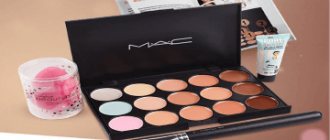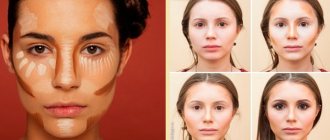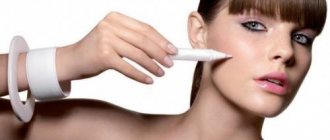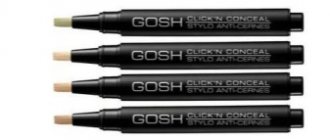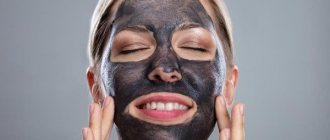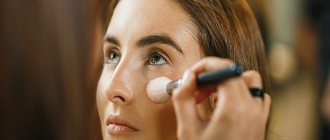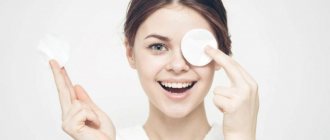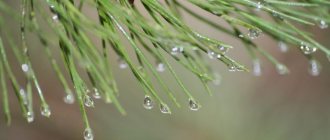- 1025
- 30-07-2020
- Author: Mysekret Team
- 0
Concealer has long been no longer one of the beauty products used exclusively by professional makeup artists. Today it is in the makeup bags of most women over 25 years old. Explains what a corrector is and why it is needed.
What is facial corrector?
Green concealer helps cover up acne
A facial corrector is a cosmetic product designed for spot correction of problem areas of the skin. It is used to disguise acne, age spots, scars, and wrinkles.
Doesn’t concealer perform all these functions?, you ask, and their names are similar. But in fact, these are two different cosmetic products, although they perform a number of similar functions.
For example, both corrector and concealer mask imperfections on the face, and also even out the tone, preparing it for the application of foundation. However:
- The concealer is a creamy, loose texture with a predominantly beige hue. It is used to camouflage large areas, such as the area under the eyes, when dark circles need to be removed.
- The corrector is denser and can be of different colors - green, red, yellow, purple, beige. It is designed for spot camouflage: pimples, acne scars, age spots, etc.
Today, many cosmetics manufacturers combine the properties of concealer and corrector, producing one palette or universal creamy product. But professional makeup artists recommend abandoning “2 in 1” or “3 in 1” beauty products and using everything separately.
Corrector and concealer are not the same thing. Read 7 important differences here.
Chromatic circle in makeup: secrets of color selection
Color correction is based on the principle of color neutralization, and without understanding it, using a palette of face correctors correctly will not be easy. In the chromatic circle, all colors of the visible spectrum have an opposing color opposite them. For example, opposite blue is orange, and opposite red is green. When these shades are superimposed on each other, they are neutralized, and in order to disguise a defect, you just need to determine its color.
The standard corrector palette includes the following shades:
- green;
- lilac;
- blue;
- yellow;
- orange;
- pink;
- peach;
- white;
- beige;
- brown.
If the set is large, then it contains several shades of each color of varying saturation. The rule that works here is that the more intensely colored the defect, the richer the shade needed to camouflage it. Depending on the nature of the problem, different color combinations will be useful to you.
Green
The most popular among owners of oily and combination skin, as it fights the main manifestations of inflammatory reactions. Its use is justified in the following cases:
- red inflammatory spots;
- redness around pustules (pimples);
- burst blood vessels;
- insect bites;
- fresh scratches.
Dark-skinned and snow-white
Keep in mind that the darker the natural shade of your skin, the richer the color of the corrector you will need. Pale green will help disguise redness on fair skin, while dark-skinned girls are better off using an olive or mustard tone. Do not ignore this rule, since using a palette of correctors for the face without taking into account skin color is unacceptable.
Yellow
This color is useful for neutralizing the blue-violet tones, the manifestations of which often affect girls with thin skin and superficially located blood vessels. Feel free to apply yellow concealer to the following areas:
- blue and purple circles under the eyes;
- translucent venous network;
- rosacea;
- fresh hematomas.
Keep in mind that applying a yellow tone to undamaged areas is unacceptable, as it will give the face an unhealthy yellowness. When applying the corrector, do not slightly reach the edge of the defect, because during shading the yellowness will spread slightly to the sides and cover the entire problem area. This is a universal norm that works for all colors, and without following it, it will not be possible to correctly apply a palette of correctors to your face.
Lilac
Looking at the chromatic circle, it is not difficult to guess that the lilac-lilac-violet range is intended to hide the shortcomings of yellow-orange and brown shades. Feel free to apply lilac to the following imperfections:
- age spots, melasma;
- freckles;
- uneven tan;
- old icteric hematomas.
This corrector is most in demand among women of the older age group who are faced with the problem of photoaging. The pigmentation accompanying it forces the use of a palette of correctors for the face in lilac shades.
Makeup gadgets
The Beauty Blender is the perfect sponge for applying and blending cosmetics. Its pointed edge will reach the most difficult areas in the corners of the eyes and near the nose, while the opposite wide part will quickly cope with large areas. Don't forget to wet it before use so that your makeup comes out subtle and weightless.
Pink
Not the most used color, since its opponent is shades of green, which are an infrequent guest on the face. The pink corrector is used locally only at the appropriate stage of hematoma involution. But it finds diffuse application more often.
Girls whose whole face has a pale, greenish or earthy tint should not apply the corrector over the entire surface, because this may give too dense coverage without the possibility of blending. In this case, a little life hack will come to the rescue: mix a little of your usual foundation or makeup base with a pink liquid corrector. The resulting mixture can be used to cover the entire face.
White and beige
These colors are universal and are often used by beginners to camouflage all types of skin imperfections. But classic makeup with a palette of face correctors implies their use only for highlighting and darkening individual areas of the face using the contouring or sculpting technique.
What types of facial correctors are there: types and descriptions
Makeup corrector comes not only in different colors, but also in different shapes. You need to choose a product depending on what tasks are expected to be assigned to it, as well as on your skin type.
There are 5 main types of face corrector used in makeup:
- Liquid;
- In the form of a stick;
- Pencil;
- Cream;
- Tonal;
- Dry (crumbly).
Liquid for quick concealment
Liquid face corrector comes in a small tube with a brush, like a lip gloss. It is usually beige in color. Suitable for dry and normal skin. Can be used when applying age makeup, daytime, evening. Masks pigment spots, dark circles under the eyes, acne. Not suitable for correction of eyebrows and lips.
Acne corrector stick
The corrector stick is convenient to use if necessary to disguise a pimple or age spots. It is also used to correct the shape of the face. For example, they darken the wings of the nose to visually make it narrower. The stick is also suitable for highlighting cheekbones.
Pencil
Corrector pencil is usually chosen in a beige shade to match the skin color or white. The first is used for eyebrow makeup. With its help you can select and correct their shape. Read about what eyebrow shape is the most fashionable now in this article.
A white corrector pencil is applied to the inner corner of the eyes, under the eyebrow, and highlighted on the lips. It is often used instead of highlighter.
Creamy corrector - for perfect makeup
If you are planning evening, wedding makeup or for a photo shoot, it is important to apply professional makeup to your face. In this case, you won’t be able to get by with just a beige color corrector, since you need to mask all the problem areas. For this purpose, green, red, and blue correctors are used.
Cream correctors usually come in a palette of 6 or more shades. This is the most convenient form, as you can prepare the skin for applying any type of makeup, hiding all imperfections.
Important: do not confuse the corrector palette with the contouring palette, which contains all shades of brown.
Tonal or “2 in 1”
The foundation corrector is a “2 in 1” product and combines the properties of foundation and corrector. The shade is selected to match the skin color. Apply to face with a makeup brush or sponge. Release form: tube or bottle with dispenser.
Loose corrector - for oily skin
Dry or crumbly concealer is not the most popular type of this product, however, if your skin is oily in the summer, you should pay attention to it. It will help remove oily shine and correct imperfections such as redness, acne scars, and age spots.
Secrets of makeup artists
Using the tricks of professionals, you can significantly transform your appearance.
To ensure that the concealer is invisible in the area under the eyes, it should be applied in the shape of an inverted triangle with a special brush or fingers, while carefully blending. The corrector can be used instead of an eyeshadow base
A color slightly lighter than the skin is selected and applied in a thin layer to the eyelid; you can even apply it to the sub-brow area, adjusting the shape of the eyebrows. By drawing a line close to the lips with the corrector, you can visually enlarge them, and also preserve the pigment of the lipstick or the shine of the gloss for a long time. When it comes to evening makeup, then you should pay special attention to yellow concealer; it will give the skin a slight glow and an even tone. If suddenly the layer of product turns out to be too thick, then just gently blot off the excess with a dry cloth. Concealer helps to correct the shape of the eyebrows; to do this, you need to choose a product that is a tone lighter than your skin and carefully apply it above and below the eyebrow arch, and then carefully shade it. To contour your face, you need to choose a concealer that is two shades lighter and two shades darker, then, preferably in a room with natural light, you need to apply a light concealer to areas that catch natural light and a dark concealer to areas where there are light shadows. Many girls, when designing arrows before their eyes, have to deal with the problem of curved lines, often this ends with complete removal of the arrows and repeating the art again, but this can be avoided with the help of a proofreader; if they notice an error, it is masked, as if an eraser is erasing a simple pencil from paper. If there are unsightly pimples on the chest and décolleté, you can hide them. A concealer that matches the skin tone is applied, and translucent powder is applied on top, and so on in several layers until the imperfections are hidden from view. By choosing concealers with vitamin E, you can help dry skin become hydrated and healthy.
How to use face corrector?
The corrector is applied under the foundation. It can be applied directly to cleansed facial skin or after makeup primer. By the way, this is another difference from concealer, which is applied on foundation, and not under it or along with it.
Corrective facial pencil, cream, stick must be used correctly. To do this, it is important to understand exactly what shades need to be applied to problem areas.
Purple
Purple concealer helps cover up yellow spots. Apply under foundation to problem areas. Also, the lavender shade helps give the skin a natural glow. It is necessary for women with pale skin tones.
Yellow
Yellow corrector is suitable for neutralizing dark circles under the eyes. It also masks purple-red scars on the face well. Applied precisely. It is recommended to use cream or foundation for these purposes.
Orange
Orange corrector is used like yellow, but only if the skin is tanned or dark. Apply pointwise and blend with a sponge.
Pink
If the circles under the eyes have a green, blue, or purple tint, a pink cream corrector, liquid or stick, is suitable. Apply in small strokes and spread evenly with a sponge or makeup brush. Pink corrective cream is also used to disguise acne spots on pale skin.
Green
Green concealer is great for concealing acne scars and blemishes. It can also be used to hide an unexpected pimple on the nose, cheek, forehead or chin. Apply foundation on top in a thick layer.
White
A white cream corrector or in the form of a pencil is used instead of highlighter. And liquid is suitable for giving the foundation the desired shade. Simply mix white corrective cream with foundation to achieve a lighter shade that matches your skin.
Common mistakes
There are times when the concealer seems to be chosen correctly, but it is not possible to disguise defects on the skin. At best, the result is a powdery effect, at worst - peeling plaster. It's all about technique and application rules.
If they are violated, it is difficult to achieve the desired result. But it happens that even fulfilling the requirements does not help hide the problem area. A selection of mistakes that women most often make when making makeup will help prevent disappointment.
If you take them into account, it will be much easier to make defects invisible:
- Concealer should not be applied to dry skin, as it will be impossible to blend it out.
- It is better to do shading with a brush. Its soft structure will not affect the cream base of the product.
- To achieve effective camouflage, concealer should be applied only after foundation. If you break the sequence, the result will not be satisfactory.
- A thick layer of masking composition will not give the desired effect. The initial, seemingly good result will become an unpleasant accent on the face after half an hour. Crackling and delamination will resemble old plaster falling off the wall of a house. If the structure of the cream has become denser over time, it can be diluted before using as a makeup base.
- The area around the eyes should initially be treated with day cream, and after drying it, a concealer should be used. This way, small wrinkles will be filled in, and after adjustment they will not pile into folds.
- It is recommended to correct the area around the eyes with a concealer that is a tone lighter than your skin color.
https://youtube.com/watch?v=77zu2f7GKmU
Makeup with concealer: step-by-step instructions
How to properly apply concealer to your face so that neither blue, nor green, nor yellow undertones are visible? To do this, it is important to blend the corrective makeup base well and then cover it with foundation.
Face corrector: step-by-step instructions on how to use correctly
- STEP 1: The first step is to cleanse your skin. To do this, use foam for washing, then toner;
- STEP 2: The second stage is moisturizing with cream;
- STEP 3: Apply makeup primer;
- STEP 4: Apply the corrector of the desired color to problem areas dotted or in small strokes and blend it with a sponge;
- STEP 5: Apply foundation over concealer with a brush;
- STEP 6: Use a concealer under your eyes if your dark circles don't seem to be covered well enough;
- STEP 7: Apply blush to cheekbones;
- STEP 8: Use highlighter on cheekbones, chin, tip of nose, under eyebrows;
- STEP 9: Powder your face.
- STEP 10: Start making up your eyebrows, then your eyes and lips.
Review of popular palette brands
How to use certain brands of facial correctors is indicated on each palette from the manufacturer's brand. A rating based on customer reviews will help you choose the right set. All of the products listed have good covering power and last a long time on the skin. The average durability of the products listed is 6 hours or more.
Popular palettes:
- MAC corrector palette 15 colors (1000 rub.). Thick texture, but does not clog pores, good durability up to 8 hours, suitable even for sensitive skin. If necessary, the colors can be mixed with each other to obtain the desired shade.
- Urban Decay (1500 rub.). Light airy texture is easy to apply without weighing down the skin, contains vitamins E and C. It is characterized by economical use and good masking properties.
- Holika Holika (500 rub.). The compact release form contains natural plant extracts. Rejuvenates and moisturizes the skin, fights inflammation.
- NYX Professional Makeup (1800 rub.). The palette consists of 20 shades. Light texture, contains vitamin E, aloe extract and antiseptic additives.
- Maybelline (800 rub.). Delicate texture, easy application, high durability, neutralizes redness and other visible imperfections.
- Faberlic (200 rub.). Smooth, non-sticky texture does not leave stains on clothes. Apply with light pats, which eliminates stretching and deformation of the skin during application. Provides even coverage throughout the day. The line is represented by yellow, green, purple and pearl correctors.
- CATRICE Allround Concealer (RUR 300). This budget-friendly palette of color correctors conceals circles, redness and age spots.
Summarize
A face corrector is necessary for almost every woman, since it is extremely difficult to find a person with perfect skin. The corrector helps to disguise imperfections on the face accurately and precisely. There is no need to cover your entire face with a thick layer of foundation when the pimple is only on your forehead or chin. It is enough to apply the corrector of the desired color to the problem area, and then cover it with foundation.
The use of correctors in everyday makeup has long become the norm, and for the evening version it is completely necessary. Do you use makeup correctors?
Share with your friends!
Read us in the Zen channel
